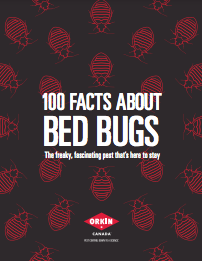Once upon a time, bed bugs played little more than a bit part in a children’s nursery rhyme. But since they scuttled out of obscurity into the limelight more than a decage ago, the North American public has found it hard to sleep tight. Bed bugs have inspired everything from disgust and dread, to myths and misconceptions – not to mention making heir fair share of headlines.
Bed bugs are peculiar. It’s not surprising these creepy creatures sparked panic among their human hosts, who found themselves fed upon in the dark of the night while seemingly safe in their beds. For a time, people felt like they could escape the pests by the light of day. That’s until bed bugs started showing up in offices. And in retail centers. And theaters. And libraries. Though it sounds like a Hitchcockian horror movie, it’s just a typical day’s work for your Orkin Canada technician.
We were early observers of the reemergence of bed bugs, and we’ve been on the frontlines of the battle against them ever since.
From our learnings, we rounded up 100 facts about bed bugs! To give you a little preview of some of these bed bug facts, we’ve listed 10 interesting facts from our top 100.
Ten Facts About Bed Bugs
- The bed bug species most common in North America is Cimex lectularius, which translates literally to “bug of the bed or couch.” If you’re fluent in Latin, you already knew that.
- With a flat, broad, oval shape and dark brown coloring, adult bed bugs are small (4-5 mm long) but visible to the naked eye.
- Bed bugs have six legs, three body segments and four-part antennae, making them “true bugs.” And, according to The Orkin Man, they are also true pests.
- As nocturnal pests, bed bugs prefer to feed at night but will seek a food source during the day if necessary. They are most active between the hours of midnight and 5 a.m.
- A bed bug feeding takes about five minutes. Humans, it would seem, are pretty fast food.
- Bed bugs can ingest more than seven times their body weight at one time. That’s the equivalent of a 150-pound adult drinking 473 LITRES of water in one sitting.
- A female bed bug lays about 100-150 eggs in her lifetime.
- Bed bugs originated with cave dwellers co-habitating with bats, the original host of these blood-sucking insects. At some point about 245,000 years ago, bed bugs expanded the menu from bats to humans.
- A study conducted by the University of Florida and Union College in Lincoln, Neb., found that the colours red and black attract bed bugs while green and yellow are more repellent. Fans of the Montréal Canadiens, Calgary Flames and Ottawa RedBlacks are not pleased. Meanwhile, Saskatchewan Roughriders fans rejoiced.
- Bites may also indicate bed bug presence. However, as many as 30 percent of people do not react to bed bug bites. In some cases, other insect bites may be mistaken for bed bug bites.
Looking to learn the other 90 Bed Bug FACTS? Click here to get learning.
You may also like
Canada's Top 25 Bed Bug Cities Of 2023
Bed bugs are extremely efficient hitch hikers. They can move easily across a room and climb onto luggage or anything left on a bed in just one night. Learn which cities have made Canada’s top 25 bed buggiest cities.
Canada's Top 25 Bed Bug Cities Of 2022
Bed bugs are extremely efficient hitch hikers. They can move easily across a room and climb onto luggage or anything left on a bed in just one night. Learn which cities have made Canada’s top 25 bed buggiest cities.
Bugs & Kisses: Tips To Keep Pests Out Of Your Valentine's Day
Valentine’s Day is a holiday that’s all about spreading love and kindness. Unfortunately, the sweetness of this tradition also makes it an opportunity to attract and harbour pests, which can lead to serious pest infestations. If love is in the air at your property this year, it is important to take precautions against the various pests that intend to intrude on your plans. Whether you’re celebrating love day with family, friends, or a significant other, the gathering and gift giving traditions that go hand-in-hand with Valentine’s Day increase the probability of pests reaching you or your home. To help you avoid insects spoiling your romance, we’ve provided you with some tips on how to have a pest-free Valentine’s Day.
Who Invited That Pest? Tips To Avoid Pest Infestation At Your Next Party
Everyone loves a good party, but so do pests. For those looking to host a successful party, it is important to be aware of the possibility of having some uninvited guests…we mean pests. Whether you're hosting a Super Bowl party, throwing a birthday bash, or enjoying a night in with friends, remember that pests are popular party favours that may be left behind. While there’s not much you can do to prevent these pests from entering your home via your guests, you can take precautions to nip the problem at the source and avoid an infestation. To make it easier for you, we’ve put together a few tips to make sure your party stays pest-free.
Remove pests from your home, and stop them from coming back
We work hard to listen, understand and assess your unique situation. Request a free, no-obligation estimate today for a customized pest program that fits your needs.
Request a Free Home EstimateRequest a Free Business Consultation


